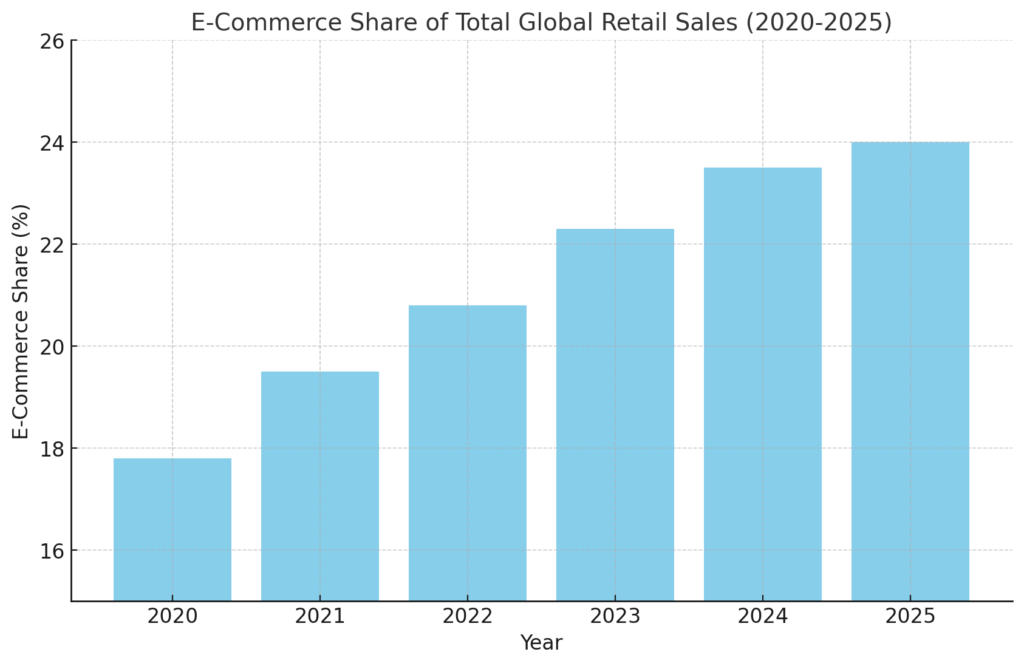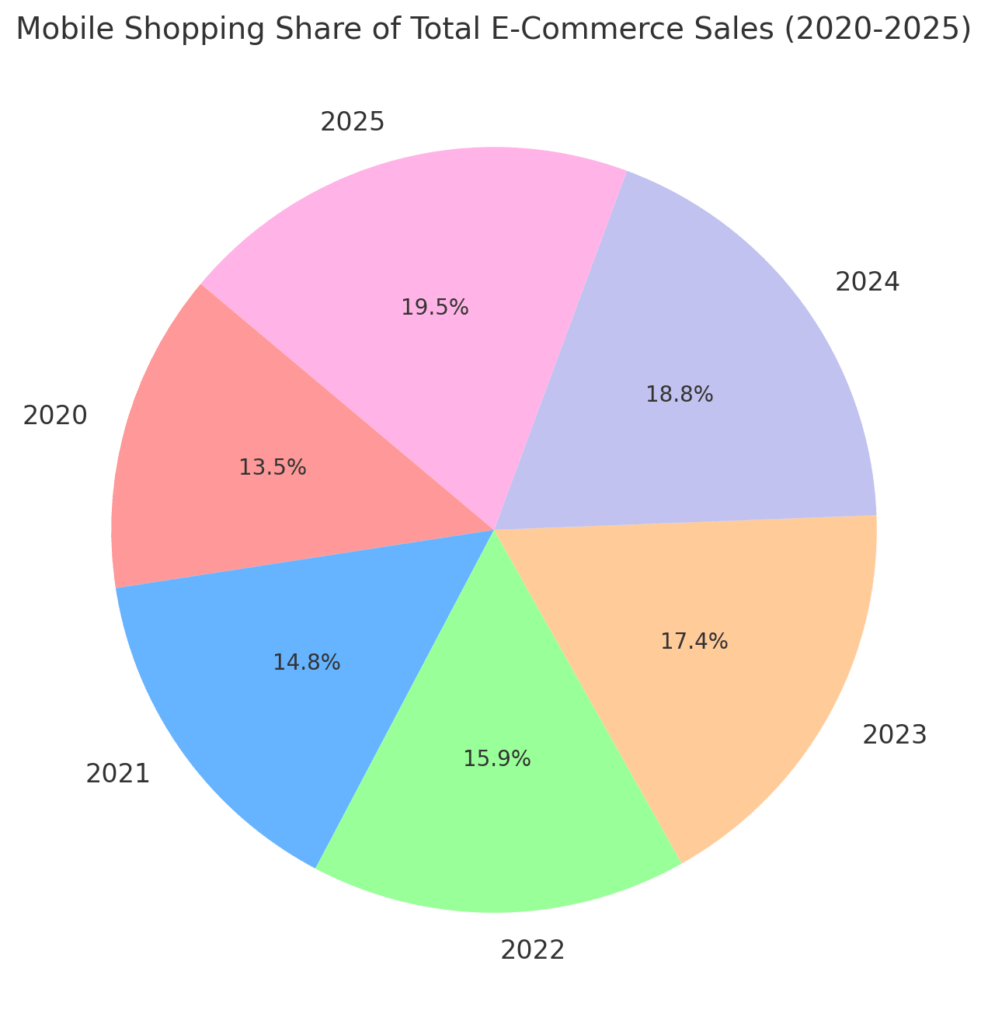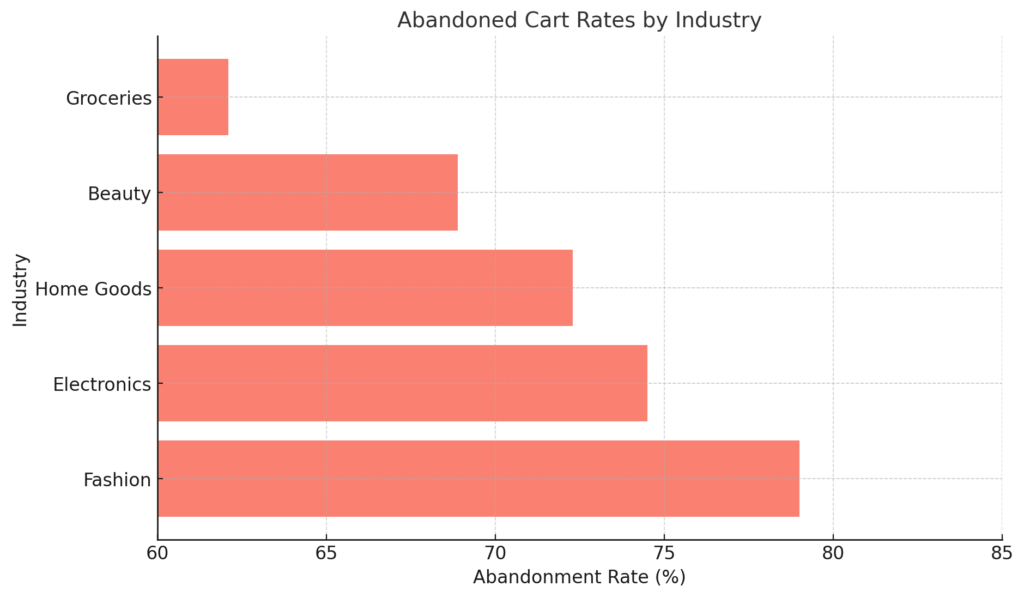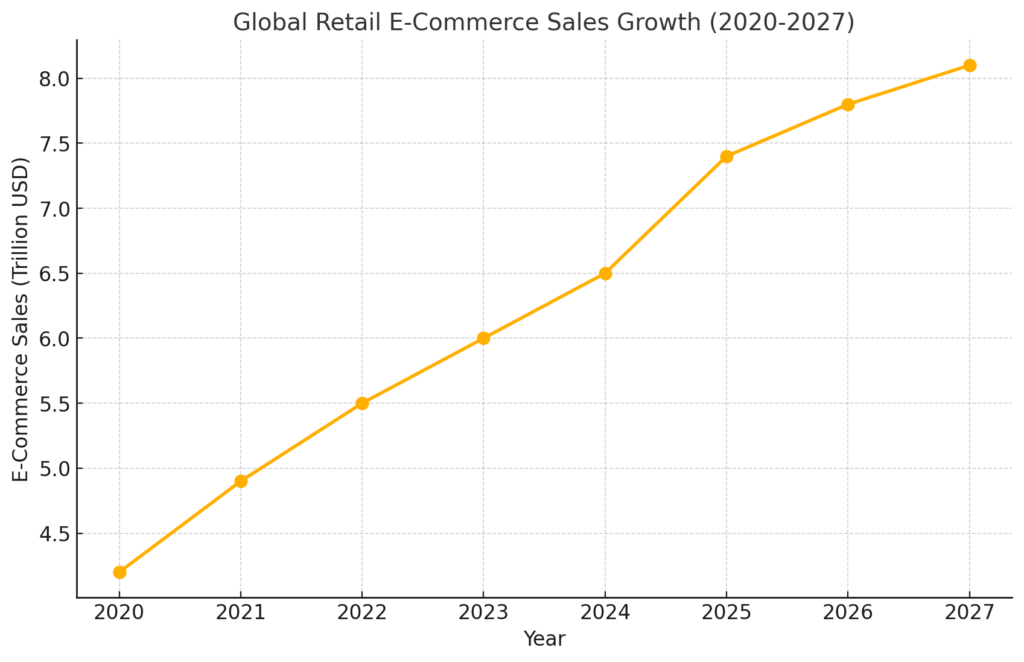09 Mar TOP E-COMMERCE MARKETING STATISTICS 2025
Posted at 13:28h in
Report by Aljay Ambos E-commerce continues to evolve at a rapid pace, reshaping the way businesses and consumers interact in the digital marketplace. With online sales projected to surpass $7.4 trillion by 2025, emerging trends in mobile shopping, AI-driven personalization, and social commerce are redefining retail strategies. As consumers demand faster, more seamless experiences, businesses must adapt by optimizing their platforms, leveraging new technologies, and addressing growing concerns about data security. The rise of augmented reality (AR), voice commerce, and blockchain solutions is further transforming how products are discovered, purchased, and delivered. Meanwhile, Amra and Elma believes that changing consumer behaviors—such as the growing reliance on online reviews, personalized recommendations, and subscription services—are influencing e-commerce success. These 20 key statistics highlight the most significant shifts shaping the future of digital commerce and provide insights into what businesses must prioritize to stay ahead in an increasingly competitive landscape.
TOP E-COMMERCE MARKETING STATISTICS 2025 (Editor’s Choice)
Here are 20 essential e-commerce marketing statistics, reflecting both historical trends and projections for 2025:
1. Global E-commerce Sales Growth: Retail e-commerce sales worldwide are projected to reach $7.4 trillion in 2025, a significant increase from $4.2 trillion in 2020.
2. E-commerce Share of Total Retail Sales: By 2025, e-commerce is expected to account for 24% of total global retail sales, up from 20% in 2023.
3. Mobile Shopping Dominance: 75% of consumers will use their mobile phones to complete purchases from start to finish by 2025.
4. Cross-Border E-commerce Expansion: Cross-border e-commerce is anticipated to grow by 108% between 2023 and 2028, highlighting the increasing importance of international markets.
5. Fashion Industry Leadership: The fashion sector leads in e-commerce revenue globally, with total sales reaching $990 billion.
6. Influence of Online Research: 63% of shopping instances begin online, underscoring the critical role of digital presence in consumer decision-making.
7. Impact of Site Speed on Conversions: For every one-second improvement in site load time, conversion rates can increase by 17%.
8. Abandoned Cart Rates: The average cart abandonment rate is 69.82%, indicating a significant opportunity for retailers to optimize the checkout process.
9. Role of Personalized Recommendations: 49% of customers have purchased products they did not initially intend to buy due to personalized product recommendations.
10. Conversion Rates from Reviews: Product listings with reviews have been shown to increase conversion rates by 38% for electronics and home appliances, and by 23% for online clothing stores.
11. Voice Commerce Adoption: With 75% of US households owning a smart speaker in 2025, voice commerce is becoming an integral part of the shopping experience.
12. Augmented Reality (AR) Integration: The number of AR users in the US is expected to exceed 100 million by the end of 2025, enhancing online shopping experiences by allowing virtual product trials.
13. Social Commerce Growth: Social media platforms are projected to account for 19.4% of total online sales in 2024, with revenues expected to reach $8.5 trillion by 2030.
14. AI-Driven Personalization: 92% of businesses are utilizing AI to enhance e-commerce experiences, leading to more personalized shopping journeys.
15. Data Security Concerns: Over 81% of consumers are concerned about how businesses use their data, emphasizing the need for robust data security measures.
16. Livestream Shopping Popularity: US livestreaming e-commerce sales reached $50 billion in 2023 and are expected to grow to $68 billion by 2026, blending entertainment with real-time shopping experiences.
17. Subscription Model Expansion: The global e-commerce subscription market is projected to reach $904.28 billion by 2026, reflecting consumers’ growing preference for curated, recurring deliveries.
18. Blockchain for Transparency: The global blockchain technology market is expected to grow from $17 billion in 2023 to over $943 billion by 2032, enhancing transaction security and transparency in e-commerce.
19. AI-Powered Customer Service: 47% of AI-mature companies identify customer service as one of the top three business functions benefiting from AI, leading to improved user experiences.
20. Composable Commerce Adoption: Brands are increasingly adopting composable commerce to quickly integrate features like shopping carts and payment gateways without redesigning their platforms, enhancing scalability and agility.
These statistics underscore the dynamic nature of the e-commerce landscape, highlighting the importance of technological advancements, consumer behavior shifts, and strategic adaptations in shaping the future of online retail.

TOP E-COMMERCE MARKETING STATISTICS 2025 and Future Implications
TOP 2025 #1. Global E-commerce Sales Growth:
Retail e-commerce sales are projected to hit $7.4 trillion by 2025, reflecting a significant expansion from $4.2 trillion in 2020. This exponential growth underscores the increasing consumer preference for online shopping and the continuous evolution of digital retail strategies. As more brands invest in digital storefronts and optimize their logistics, competition will intensify, pushing retailers to refine user experiences. The growth also signals rising investments in AI-driven personalization, faster delivery solutions, and omnichannel integrations. Additionally, marketplaces like Amazon, Alibaba, and Shopify will continue shaping global e-commerce trends, setting higher standards for customer service and efficiency. Businesses that fail to adopt emerging technologies risk losing market share to more agile competitors. Moving forward, companies must prioritize seamless checkout experiences, data-driven marketing, and sustainability initiatives to align with evolving consumer expectations.
TOP E-COMMERCE MARKETING STATISTICS 2025 #2. E-commerce Share of Total Retail Sales:
By 2025, e-commerce is expected to represent 24% of total global retail sales, up from 20% in 2023. This shift signals a decline in traditional brick-and-mortar dominance, forcing retailers to adopt digital-first strategies. Brands that once relied on in-store experiences must rethink their approach, integrating online and offline sales channels to remain competitive. Retailers will need to invest in AI-driven chatbots, virtual shopping assistants, and immersive technologies like augmented reality (AR) to replicate the in-store experience digitally. The rise in e-commerce’s share also means heightened cybersecurity concerns, as more transactions occur online. Fraud prevention tools and secure payment gateways will be essential to building consumer trust. As digital commerce continues expanding, companies must strike a balance between automation and personalization to drive engagement and customer loyalty.
TOP E-COMMERCE MARKETING STATISTICS 2025 #3. Mobile Shopping Dominance:
With 75% of consumers expected to complete purchases on mobile devices by 2025, mobile-first strategies will be a necessity rather than an option. Retailers must optimize their websites for fast loading speeds, intuitive navigation, and seamless payment integrations like digital wallets and one-click checkout. Mobile commerce will also drive greater investments in social shopping, as platforms like Instagram, TikTok, and Facebook refine their in-app purchase features. Businesses that fail to adapt to mobile shopping behaviors risk alienating a vast portion of their audience. Additionally, 5G networks will enhance mobile shopping experiences, allowing for high-speed browsing and real-time AR try-ons. As more consumers rely on smartphones for shopping, brands will need to prioritize mobile-first marketing, leveraging push notifications, SMS marketing, and location-based promotions. The future of e-commerce will be defined by how well businesses cater to mobile users.
TOP E-COMMERCE MARKETING STATISTICS 2025 #4. Cross-Border E-commerce Expansion:
Cross-border e-commerce is set to grow by 108% between 2023 and 2028, opening new opportunities for brands to reach international markets. Companies that embrace global expansion will benefit from diversified revenue streams and access to new consumer bases. However, this growth also presents logistical challenges, including international shipping costs, regional compliance regulations, and localization efforts. Brands will need to refine their translation services, payment methods, and customer support to cater to different cultural and language preferences. Additionally, global trade policies and tariffs may impact cross-border commerce, requiring businesses to stay informed on shifting regulations. The rise of international e-commerce also signals increased competition, making differentiation through branding and product uniqueness essential. To thrive in the global market, businesses must invest in multi-currency support, localized marketing, and strategic partnerships with regional logistics providers.
TOP E-COMMERCE MARKETING STATISTICS 2025 #5. Fashion Industry Leadership:
The fashion industry remains the top-grossing e-commerce sector, with global sales projected to reach $990 billion. This growth is driven by digital-native brands, fast fashion, and the increasing influence of social commerce. Online shopping behaviors have shifted towards personalized recommendations, virtual try-ons, and influencer-driven purchases. Sustainability concerns, however, are forcing brands to reconsider their supply chains and embrace circular fashion models. As consumer demand for transparency grows, blockchain-based tracking and ethical sourcing will become competitive advantages. Additionally, AI-powered styling assistants and generative fashion design will shape future trends, allowing brands to offer hyper-personalized experiences. The dominance of fashion e-commerce highlights the importance of agility, digital innovation, and sustainability in retaining customer loyalty.

TOP E-COMMERCE MARKETING STATISTICS 2025 #6. Influence of Online Research:
With 63% of shopping journeys beginning online, businesses must prioritize content marketing, SEO, and product visibility. Consumers increasingly rely on search engines, reviews, and social proof before making purchasing decisions. This trend means that brands without a strong digital presence risk being overlooked. Video content, blog posts, and influencer partnerships will play a crucial role in capturing consumer interest early in the buying process. Additionally, AI-powered search optimization will allow brands to better target their ideal audiences based on search intent. Companies must also consider voice search optimization, as more consumers use smart assistants like Alexa and Google Assistant for product research. Ensuring high-quality, relevant content at each stage of the customer journey will be key to driving conversions.
TOP E-COMMERCE MARKETING STATISTICS 2025 #7. Impact of Site Speed on Conversions:
A one-second improvement in site load time can increase conversion rates by 17%, making website performance a top priority for e-commerce businesses. Slow-loading pages not only frustrate users but also lead to higher bounce rates and lost sales. Retailers must invest in faster hosting solutions, image optimization, and efficient coding practices to enhance site speed. Google’s Core Web Vitals update has also made page speed a ranking factor, affecting search visibility. Businesses that fail to optimize their websites risk lower organic traffic and diminished sales potential. Additionally, mobile responsiveness plays a significant role, as most users now browse and shop on smartphones. Future e-commerce success will depend on delivering lightning-fast, seamless browsing experiences to retain customer attention.
TOP E-COMMERCE MARKETING STATISTICS 2025 #8. Abandoned Cart Rates:
With the global cart abandonment rate averaging 69.82%, optimizing checkout processes is crucial for e-commerce profitability. Consumers often abandon their carts due to hidden fees, complicated checkout steps, or security concerns. Implementing transparent pricing, guest checkout options, and multiple payment methods can reduce friction. Personalized abandoned cart email reminders and retargeting ads can also help recover lost sales. Businesses should explore innovations like buy-now-pay-later (BNPL) options and digital wallets to increase checkout completion rates. As competition intensifies, brands must prioritize a frictionless and reassuring checkout experience. Addressing abandonment issues will lead to higher revenue retention and improved customer satisfaction.
TOP E-COMMERCE MARKETING STATISTICS 2025 #9. Role of Personalized Recommendations:
With 49% of consumers purchasing items they did not initially intend to buy due to personalized recommendations, AI-driven product suggestions are shaping modern e-commerce. These tailored experiences increase revenue and customer satisfaction by making shopping more intuitive. As machine learning continues improving, recommendation engines will become even more precise, predicting needs before customers even express them. Brands must invest in dynamic content personalization, ensuring that customers receive relevant offers based on browsing history, purchase behavior, and preferences. However, balancing personalization with data privacy concerns will be critical, as consumers become more aware of how their data is used. Businesses that implement transparent AI-driven recommendations while respecting user privacy will foster trust and loyalty. In the future, hyper-personalized shopping experiences will be a competitive advantage, driving higher conversion rates and customer retention.
TOP E-COMMERCE MARKETING STATISTICS 2025 #10. Conversion Rates from Reviews:
Product listings with reviews increase conversion rates by 38% for electronics and home appliances, and by 23% for clothing, proving that social proof significantly impacts buying decisions. Consumers are more likely to trust peer feedback over brand messaging, making user-generated content a valuable marketing asset. Businesses must actively encourage customers to leave reviews through incentives, loyalty programs, or post-purchase emails. Additionally, AI-powered sentiment analysis can help brands extract insights from reviews to improve products and customer service. Negative reviews should not be ignored, as addressing concerns transparently can enhance brand credibility. Video reviews and influencer testimonials will become even more influential, especially in social commerce. Moving forward, integrating authentic customer feedback into product pages will be essential for driving sales and brand trust.

TOP E-COMMERCE MARKETING STATISTICS 2025 #11. Voice Commerce Adoption:
With 75% of US households expected to own a smart speaker in 2025, voice commerce will play a growing role in online shopping. Consumers are increasingly using voice assistants like Alexa, Google Assistant, and Siri to search for products, compare prices, and place orders. This shift means businesses must optimize their content for voice search, using conversational keywords and structured data to improve discoverability. Additionally, frictionless voice-enabled payments will enhance the convenience of shopping via smart speakers. Retailers that integrate voice shopping capabilities early will gain a competitive edge in accessibility and user experience. Security concerns around voice transactions must also be addressed to encourage widespread adoption. As voice AI improves, e-commerce brands must adapt to a hands-free, spoken-word-driven shopping experience.
TOP E-COMMERCE MARKETING STATISTICS 2025 #12. Augmented Reality (AR) Integration:
By 2025, AR adoption in e-commerce will surpass 100 million users in the US alone, transforming how consumers interact with products online. Virtual try-on features in fashion, home decor, and beauty will reduce return rates and increase purchase confidence. Brands that invest in AR will provide customers with immersive experiences, allowing them to visualize products in real-world settings before buying. Retailers like IKEA, Sephora, and Nike have already leveraged AR, demonstrating its effectiveness in boosting engagement and conversions. As AR technology advances, small and mid-sized businesses will have greater access to cost-effective solutions, making interactive shopping more widespread. Consumers will expect AR-enhanced product pages, making static images less appealing. Moving forward, AR will redefine digital commerce, blurring the lines between physical and online shopping.
TOP E-COMMERCE MARKETING STATISTICS 2025 #13. Social Commerce Growth:
Social media platforms are projected to generate 19.4% of total e-commerce sales by 2024, with revenues expected to reach $8.5 trillion by 2030. This trend highlights the increasing influence of social networks like TikTok, Instagram, and Facebook as shopping hubs. Consumers now discover, engage with, and purchase products directly within social media apps, eliminating the need for external websites. Influencer marketing, live shopping, and short-form video content will further drive engagement and conversions. Businesses that fail to integrate social commerce risk missing out on a massive audience of digital-native shoppers. As platforms refine their shopping features, expect greater adoption of AI-powered recommendations and chat-based transactions. The future of online shopping will be increasingly embedded in social media, making community-driven commerce a dominant force.
TOP E-COMMERCE MARKETING STATISTICS 2025 #14. AI-Driven Personalization:
With 92% of businesses leveraging AI for personalization, automated customer experiences are becoming a necessity. AI-powered algorithms analyze behavior, preferences, and past purchases to deliver highly relevant product suggestions and marketing messages. This level of customization enhances engagement and increases repeat purchases, as consumers feel understood by brands. However, businesses must balance personalization with ethical data usage to maintain consumer trust. AI-driven dynamic pricing, chatbots, and predictive analytics will further refine customer journeys. Companies that fail to implement AI risk losing relevance in an increasingly data-driven landscape. As AI capabilities evolve, hyper-personalization will become the standard, reshaping how brands interact with customers at every touchpoint.
TOP E-COMMERCE MARKETING STATISTICS 2025 #15. Data Security Concerns:
With 81% of consumers concerned about data security, businesses must prioritize transparent and ethical data practices. Growing awareness of digital privacy has led to stricter regulations, such as GDPR and CCPA, requiring brands to be more responsible in handling customer information. Companies must implement robust encryption, two-factor authentication, and clear privacy policies to reassure consumers. Failure to protect customer data can result in severe reputational damage and financial penalties. Additionally, brands should offer opt-in customization options, allowing users to control how their data is used. Blockchain technology and decentralized identity verification may become essential in enhancing security. Moving forward, trust in e-commerce will depend on a brand’s ability to provide secure, transparent, and user-controlled data experiences.

TOP E-COMMERCE MARKETING STATISTICS 2025 #16. Livestream Shopping Popularity:
Livestream e-commerce sales in the US reached $50 billion in 2023 and are projected to hit $68 billion by 2026. This trend merges entertainment with online shopping, allowing brands to engage customers in real time. Influencers and brands host live demonstrations, answer questions, and offer exclusive deals, making the experience more interactive than traditional e-commerce. China has already demonstrated the potential of livestream shopping, with companies like Alibaba and Douyin generating billions in sales. As Western markets catch up, businesses must experiment with live events to build stronger connections with audiences. The future of retail will be increasingly experiential, where storytelling and real-time engagement drive purchasing decisions. Brands that capitalize on this format will benefit from higher conversion rates and deeper customer relationships.
TOP E-COMMERCE MARKETING STATISTICS 2025 #17. Subscription Model Expansion:
The e-commerce subscription market is projected to reach $904.28 billion by 2026, reflecting growing consumer interest in recurring deliveries and curated experiences. Subscription services provide businesses with predictable revenue streams and increase customer lifetime value. However, maintaining customer retention will be crucial, as consumers are quick to cancel underwhelming subscriptions. Brands must prioritize personalized offerings, flexible pricing, and exceptional service to sustain long-term success. AI-driven recommendations will play a key role in tailoring subscription experiences to individual preferences. Additionally, sustainability-focused subscriptions, such as refillable packaging and ethical sourcing, will appeal to environmentally conscious consumers. The future of e-commerce will see a greater shift toward automated, recurring transactions, making convenience and exclusivity key selling points.
TOP E-COMMERCE MARKETING STATISTICS 2025 #18. Blockchain for Transparency:
The global blockchain market is expected to grow from $17 billion in 2023 to over $943 billion by 2032, revolutionizing e-commerce security and transparency. Blockchain technology enables secure, tamper-proof transactions, reducing fraud and ensuring authenticity in supply chains. Luxury goods, pharmaceuticals, and food industries are already leveraging blockchain to enhance traceability and combat counterfeiting. Decentralized finance (DeFi) solutions will also emerge, offering alternative payment methods and reducing reliance on traditional banks. Consumers will demand greater transparency in sourcing and ethical manufacturing, making blockchain a key differentiator. As regulatory frameworks evolve, widespread adoption of blockchain in e-commerce will increase. Brands that integrate blockchain solutions will gain consumer trust while improving operational efficiency.
TOP E-COMMERCE MARKETING STATISTICS 2025 #19. AI-Powered Customer Service:
AI-driven customer service is transforming e-commerce, with 47% of AI-mature companies prioritizing automated support. Chatbots and virtual assistants handle inquiries, resolve complaints, and provide instant support, reducing wait times and operational costs. Advanced AI can analyze sentiment, detect frustration, and escalate complex issues to human representatives when needed. As AI continues learning from interactions, customer experiences will become more seamless and intuitive. However, businesses must ensure a balance between automation and human touch to maintain personalization. AI will also improve multilingual support, enabling brands to expand into global markets effortlessly. In the future, AI-driven service will be the norm, enhancing efficiency while maintaining a high level of customer satisfaction.
TOP E-COMMERCE MARKETING STATISTICS 2025 #20. Composable Commerce Adoption:
Composable commerce is gaining traction as brands seek flexible, scalable e-commerce solutions. Instead of relying on monolithic platforms, businesses can integrate modular, best-in-class components such as payment gateways, shopping carts, and personalization engines. This approach allows for faster innovation, reduced costs, and a tailored user experience. Companies can experiment with emerging technologies like AI-driven search and predictive analytics without overhauling entire systems. As consumer expectations evolve, brands that adopt composable commerce will remain agile and competitive. The future of e-commerce will favor adaptable architectures that can quickly respond to market trends. Businesses investing in modular e-commerce ecosystems will gain an edge in customization and scalability.
The Future of E-Commerce: Adaptation and Innovation
The rapid growth of e-commerce presents both opportunities and challenges for businesses looking to thrive in an increasingly digital marketplace. With mobile shopping, AI-driven personalization, and social commerce reshaping consumer expectations, brands must continuously refine their strategies to stay competitive. Emerging technologies like AR, voice commerce, and blockchain will further disrupt the industry, requiring retailers to be agile and forward-thinking. At the same time, growing concerns over data privacy and cybersecurity highlight the importance of transparency and ethical business practices. As consumer behaviors shift toward convenience, personalization, and seamless omnichannel experiences, companies that embrace innovation will build lasting relationships and drive sustained growth. The future of e-commerce belongs to those who anticipate change, adopt new technologies, and create engaging, customer-centric experiences that go beyond transactions.
Sources:
- https://explodingtopics.com/blog/ecommerce-stats
- https://explodingtopics.com/blog/ecommerce-stats
- https://www.sixthcitymarketing.com/ecommerce-marketing-stats/
- https://www.sixthcitymarketing.com/ecommerce-marketing-stats/
- https://www.sixthcitymarketing.com/ecommerce-marketing-stats/
- https://www.sixthcitymarketing.com/ecommerce-marketing-stats/
- https://www.sixthcitymarketing.com/ecommerce-marketing-stats/
- https://www.sixthcitymarketing.com/ecommerce-marketing-stats/
- https://www.sixthcitymarketing.com/ecommerce-marketing-stats/
- https://www.sixthcitymarketing.com/ecommerce-marketing-stats/
- https://www.bigcommerce.com/articles/ecommerce/ecommerce-trends/
- https://www.bigcommerce.com/articles/ecommerce/ecommerce-trends/
- https://elpais.com/extra/publicidad/2025-01-25/redes-sociales-a-modo-de-bazares-orientales.html
- https://www.the-future-of-commerce.com/2024/12/04/e-commerce-trends-2025/
- https://www.the-future-of-commerce.com/2024/12/04/e-commerce-trends-2025/
- https://www.bigcommerce.com/articles/ecommerce/ecommerce-trends/
- https://www.the-future-of-commerce.com/2024/12/04/e-commerce-trends-2025/
- https://www.bigcommerce.com/articles/ecommerce/ecommerce-trends/
- https://www.the-future-of-commerce.com/2024/12/04/e-commerce-trends-2025/
- https://www.the-future-of-commerce.com/2024/12/04/e-commerce-trends-2025/






